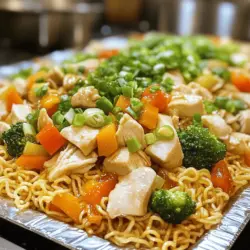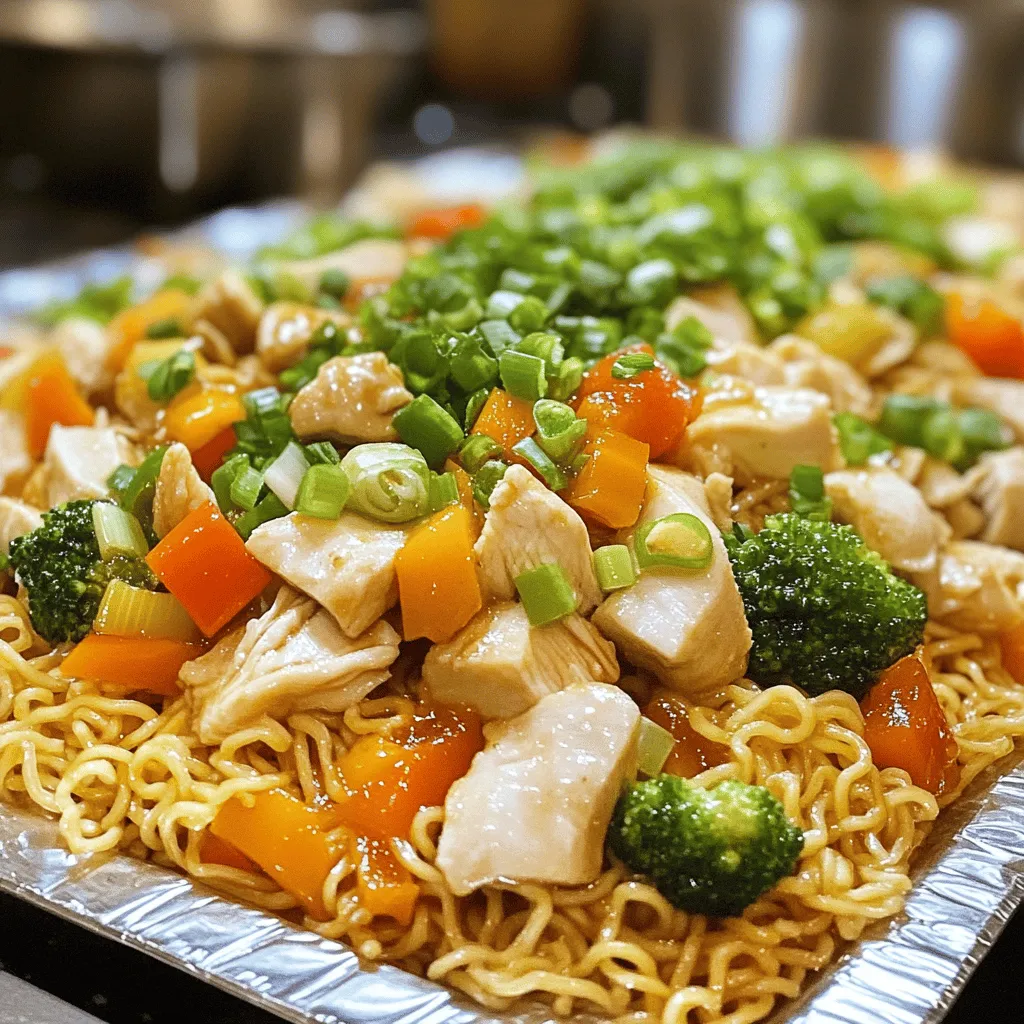Introduction
Chicken Chow Mein is a beloved staple in Asian cuisine, a dish that has captured the hearts (and palates) of food lovers around the world. This stir-fried noodle dish is not only quick to prepare but also incredibly versatile, making it a favorite for family dinners and casual gatherings alike. The combination of tender chicken, crisp vegetables, and flavorful noodles, all brought together with a savory sauce, makes Chicken Chow Mein a go-to option for those seeking a delicious meal.
One of the key factors that elevate Chicken Chow Mein from a basic dish to an unforgettable culinary experience is the sauce. Homemade sauces play a crucial role in enhancing flavors and authenticity, allowing you to control the balance of tastes to your preference. In this recipe, we will introduce you to the Ultimate Chicken Chow Mein, featuring a unique blend of sauces that will tantalize your taste buds and have you craving more. Plus, the quick preparation time ensures that you can whip up this delightful dish even on the busiest of weeknights.
The Allure of Chow Mein
The history of Chow Mein is rich and varied, originating from the Chinese word “chao mian,” meaning “stir-fried noodles.” This dish has evolved over the years, with each culture adding its own twist and flavor. In the United States, for example, Chow Mein is often served with crispy fried noodles and a variety of toppings, providing a completely different experience compared to its traditional counterparts. Variations abound, from Cantonese-style Chow Mein with soft noodles to the Americanized version that is commonly found on restaurant menus.
Chow Mein holds a special place in many families’ hearts, often served during gatherings or special occasions. The communal nature of the dish encourages sharing and brings friends and family together around the table. While takeout might be convenient, homemade versions of Chow Mein are often far superior. When you create this dish at home, you have the freedom to choose high-quality ingredients, customize the flavors, and adjust the spice level to suit your taste. The satisfaction of crafting a delicious meal from scratch is unparalleled, and it allows for a personal touch that takeout simply cannot replicate.
Ingredients for Ultimate Chicken Chow Mein
To create the Ultimate Chicken Chow Mein, you’ll need a selection of fresh ingredients that work harmoniously together to create a delicious, mouthwatering dish. Below is a detailed list of the ingredients you’ll need, along with descriptions that highlight their importance and purpose in this recipe:
Chow Mein Noodles
The foundation of any Chow Mein dish is the noodles. You can choose between fresh or dried Chow Mein noodles, depending on what is available and your personal preference. Fresh noodles offer a tender texture and a more authentic taste, while dried noodles provide convenience and a longer shelf life. When preparing the dish, be sure to cook the noodles until they are al dente for the best texture. Overcooked noodles can become mushy and lose their appeal.
Chicken Breast
For the protein element of this dish, boneless, skinless chicken breast is an excellent choice. It’s important to slice the chicken thinly against the grain to ensure even cooking and tenderness. Thin slices allow the chicken to absorb the flavors of the sauce and cook quickly, making it perfect for stir-frying.
Mixed Vegetables
A colorful mix of vegetables not only adds nutritional benefits but also enhances the visual appeal of your Chicken Chow Mein. Common vegetable choices include bell peppers, carrots, snow peas, and bean sprouts. When selecting vegetables, aim for a variety of colors and textures. Fresh, crisp vegetables will add crunch and a burst of flavor to the dish.
Essential Sauces
The secret to achieving an irresistible Chow Mein lies in the sauce. This recipe utilizes a combination of several essential sauces:
- Soy Sauce: A staple in Asian cooking, soy sauce adds depth and saltiness to the dish.
- Oyster Sauce: This sauce introduces a rich, savory flavor and a hint of sweetness, enhancing the overall taste profile.
- Hoisin Sauce: Known for its sweet and tangy flavor, hoisin sauce adds a unique twist to the dish, balancing out the saltiness of soy sauce.
- Sesame Oil: A drizzle of sesame oil brings a nutty aroma and flavor, elevating the dish to new heights.
When selecting sauces, opt for high-quality brands to ensure the best flavor. Many grocery stores now carry authentic Asian sauces, making it easier than ever to find the right products.
Tips for Sourcing Quality Ingredients
To achieve the best flavor in your Chicken Chow Mein, sourcing quality ingredients is essential. Head to your local Asian grocery store, where you’ll find fresh produce and authentic sauces that can make a significant difference in your dish. Choosing organic vegetables and free-range chicken can further enhance the quality of your meal. Always remember that fresh, high-quality ingredients are key to a successful and delicious Chow Mein.
Preparation Steps for Success
Now that you have gathered all the essential ingredients, it’s time to dive into the preparation steps that will lead you to a successful Ultimate Chicken Chow Mein.
Preparing the Noodles
Before you can create your Chow Mein, you need to prepare the noodles. Start by bringing a large pot of salted water to a boil. If you’re using dried Chow Mein noodles, cook them according to the package instructions until they are al dente, typically around 3-5 minutes. Be careful not to overcook them, as they will continue to cook slightly once added to the stir-fry.
If you have chosen fresh Chow Mein noodles, they require even less cooking time. Simply blanch them in boiling water for about 1-2 minutes, just until they are heated through. After cooking, drain the noodles and rinse them under cold water to stop the cooking process. This will also help to prevent them from sticking together.
To enhance flavor and prevent sticking, toss the cooked noodles with a small amount of oil, such as vegetable or sesame oil. This step is crucial in ensuring that your noodles maintain their texture and do not clump together during stir-frying.
Crafting the Best Chow Mein Sauce
Next, it’s time to craft the ultimate Chow Mein sauce that will tie all the flavors together. In a bowl, combine the following ingredients:
- 3 tablespoons of soy sauce
- 2 tablespoons of oyster sauce
- 1 tablespoon of hoisin sauce
- 1 teaspoon of sesame oil
- A pinch of sugar (to balance flavors)
- Optional: A dash of white pepper or chili flakes for heat
Whisk together until well blended. Each ingredient contributes to the overall flavor profile, with soy sauce providing saltiness, oyster sauce adding umami, hoisin sauce infusing sweetness, and sesame oil lending a rich aroma. Adjust the proportions to suit your taste—some may prefer a sweeter sauce, while others may lean toward a saltier flavor.
With your noodles and sauce ready, you are now primed to proceed with cooking the chicken and vegetables, leading to an exciting stir-frying experience that will culminate in your delicious Ultimate Chicken Chow Mein. Stay tuned for the next part, where we will delve into the cooking process and share tips for achieving the perfect stir-fry.

Cooking the Chicken Perfectly
The heart of any great Chicken Chow Mein lies in perfectly cooked chicken. To achieve this, start by choosing the right cut of chicken. Boneless, skinless chicken breasts or thighs are ideal for stir-frying due to their tenderness and ability to absorb flavors.
Techniques for Achieving Beautifully Browned Chicken
To ensure your chicken is beautifully browned, it’s crucial to slice it thinly against the grain. This method not only helps the chicken cook evenly but also enhances its tenderness. After slicing, marinate the chicken in a mixture of soy sauce, cornstarch, and a dash of sesame oil. This marinade not only infuses flavor but also creates a protective layer that helps the chicken stay moist during cooking.
When it’s time to cook, preheat your skillet or wok over medium-high heat. Add a tablespoon of oil, swirling it around to coat the surface. Once the oil is shimmering, add the chicken in a single layer, making sure not to overcrowd the pan. Cooking in batches may be necessary to achieve that coveted golden-brown crust. Let the chicken sear undisturbed for a couple of minutes before stirring, which will develop flavor and texture.
Importance of Removing Chicken from the Skillet to Prevent Overcooking
After the chicken is cooked through and has a nice golden color, remove it from the skillet and set it aside. It’s vital to take this step to prevent overcooking, which can lead to dry, tough meat. Remember that the chicken will continue to cook slightly from residual heat even after being removed from the skillet, so undercooking it slightly is acceptable. This technique will keep your chicken tender and juicy, enhancing the overall quality of your Chicken Chow Mein.
Stir-Frying the Vegetables
With the chicken properly cooked and resting, it’s time to focus on the vibrant vegetables that will add color, texture, and nutrition to your dish. Chow Mein is well-known for its assortment of vegetables, and a good mix will elevate your meal.
Best Practices for Stir-Frying: Heat Levels, Timing, and Order of Ingredients
For optimal stir-frying, it’s essential to maintain high heat. This rapid cooking method ensures that vegetables remain crisp and colorful. Start by adding a bit more oil to your skillet, allowing it to heat up until it shimmers.
When it comes to the order of cooking, begin with the sturdier vegetables like carrots and bell peppers, stirring them for about a minute or two until they start to soften. Following that, add in quicker-cooking vegetables such as bean sprouts, snow peas, and broccoli. This staggered approach allows each vegetable to retain its unique texture and flavor profile.
Benefits of Using a Variety of Vegetables for Color, Texture, and Nutrition
Incorporating a variety of vegetables not only makes your Chicken Chow Mein visually appealing but also adds a wealth of nutrients. For instance, bell peppers offer vitamin C, while broccoli is rich in fiber and antioxidants. The colorful mix of vegetables not only satisfies the palate but also boosts the overall nutritional value of your meal. Feel free to experiment with seasonal vegetables or whatever you have on hand to make this dish your own.
Combining All Elements
Once your chicken and vegetables are cooked, it’s time to bring the dish together.
Importance of Tossing Ingredients Thoroughly to Ensure Even Coating with Sauce
Return the cooked chicken to the skillet with the vegetables. To ensure that everything is coated evenly with chow mein sauce, pour the sauce over the mixture and toss thoroughly using tongs or a spatula. This step is essential, as it ensures that each ingredient absorbs the flavors of the sauce, creating a harmonious dish.
Insights into How the Heat of the Skillet Affects the Final Dish
Maintaining high heat during this stage is crucial. The sizzling sounds you hear as you toss the ingredients together are a good sign. This high heat helps to caramelize the sauce slightly, enhancing its flavor and creating a deliciously sticky glaze on the noodles and vegetables. Cook just long enough to heat everything through, usually about 2-3 minutes, making sure not to let it sit too long to avoid soggy vegetables.
Thickening the Sauce
To achieve the signature consistency of Chow Mein sauce, a cornstarch slurry can be utilized.
Explanation of the Cornstarch Technique and Its Purpose in Achieving the Desired Consistency
Begin by mixing a tablespoon of cornstarch with two tablespoons of cold water in a small bowl. This mixture will help thicken the sauce when added to the skillet. After tossing the chicken and vegetables, pour in the cornstarch slurry while continuously stirring. This technique will give your sauce a glossy finish that clings beautifully to the chicken and vegetables.
How to Adjust Flavors and Add Spice to Taste
Once the sauce has thickened, taste your Chicken Chow Mein and adjust the flavors as needed. If you prefer a bit more heat, consider adding a pinch of red pepper flakes or a dash of chili sauce. For additional depth, a splash of dark soy sauce can enhance the umami profile of your dish. Remember, the key is to balance flavors while personalizing the spice level to suit your preferences.
Serving Suggestions
Now that your Ultimate Chicken Chow Mein is complete, let’s discuss how to serve and enjoy this vibrant dish.
Ideas for Plating and Garnishing Chicken Chow Mein
For a stunning presentation, serve your Chicken Chow Mein in large bowls or on a platter. Garnish with sliced green onions and sesame seeds for an extra touch of flavor and visual appeal. A wedge of lime on the side can also enhance the dish with a zesty finish, allowing guests to squeeze fresh juice over their servings.
Pairing Recommendations: Which Side Dishes and Beverages Complement the Dish
Chicken Chow Mein pairs wonderfully with a variety of side dishes. Consider serving it alongside steamed dumplings or egg rolls for a complete meal. For beverages, light, refreshing options like jasmine tea or even a crisp lager complement the flavors well, while also cleansing the palate between bites.
Discussion on the Versatility of Chow Mein as a Meal Option for Lunch or Dinner
One of the best aspects of Chicken Chow Mein is its versatility. This dish can easily transition from a hearty dinner to a satisfying lunch the next day. Leftovers taste even better as the flavors meld together, making it a convenient meal prep option.
Nutritional Analysis
As you indulge in your homemade Chicken Chow Mein, it’s beneficial to understand its nutritional profile.
Breakdown of the Nutritional Profile of Chicken Chow Mein per Serving
A typical serving of Chicken Chow Mein contains approximately 400-500 calories, depending on the amount of oil and sauce used. It offers a balanced mix of macronutrients, with lean protein from the chicken, carbohydrates from the noodles, and a variety of vitamins and minerals from the vegetables.
Benefits of Including Lean Protein and a Variety of Vegetables in Your Diet
Including lean protein like chicken in your diet helps to build and repair tissues, while the variety of vegetables ensures you receive essential vitamins and minerals. This dish is a great way to meet your daily vegetable intake, making it not only delicious but also nourishing.
Discussion of Calorie Content and How to Modify the Recipe for Healthier Options
If you’re looking to reduce calorie content, consider using whole wheat noodles or a lower-sodium soy sauce. You can also increase the vegetable content by adding more greens, which will enhance the dish’s volume without significantly increasing calories. Another option is to use less oil during the cooking process or to replace the chicken with tofu for a vegetarian alternative.
Conclusion
Preparing homemade Chicken Chow Mein is not just about creating a meal; it’s an enjoyable culinary experience that allows you to explore fresh ingredients and flavors. The satisfaction derived from crafting this dish, infused with your unique touch, is unparalleled.
Whether you prefer it spicy, mild, or packed with your favorite vegetables, this recipe serves as a versatile base for personalization. So, embrace the joy of cooking and get creative with your variations to suit your taste and dietary preferences. Each time you whip up this dish, you’re not just making dinner; you’re preparing a delightful feast that the whole family will love. Enjoy your culinary adventure with the Ultimate Chicken Chow Mein!


